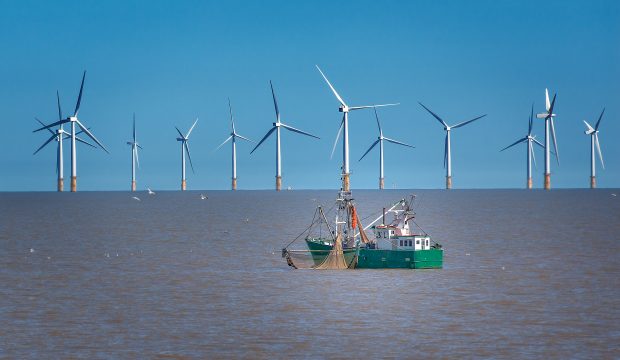For the fishing industry, the development of large-scale projects (such as offshore windfarms) in the marine area can mean displacement from customary fishing grounds and knock-on effects elsewhere.
A major purpose of the marine planning system, as recognised in the UK Marine Policy Statement, is to manage competition and enable co-existence as far as possible among a growing number of activities. Policies on co-existence are therefore integral to all the Marine Plans, which influence other policies and their implementation. Fishing and offshore windfarms are two industries with high demands for marine space, and where practical action to enable co-existence is paramount.
Compatibility
Our understanding of whether commercial fisheries can productively operate within the vicinity of offshore wind farms is still developing. Due to space requirements, some types of commercial fishing such as seine netting and pair trawling cannot physically operate among wind farms under current typical turbine layouts. There are examples of static fisheries such as crab and lobster pot fisheries operating among wind farm installations, but there is not yet conclusive evidence of significant levels of towed gear fishing activity taking place.
A report examining changes to fishing practices resulting from offshore wind farms identified several potential issues that may hinder co-existence, including:
- Potential seabed hazards from windfarm infrastructure
- Windfarm maintenance works
- Problematic communications.
As technology develops and fixed foundation turbines are installed with larger generating capacities, the spacing requirements between turbines will increase, potentially improving the prospect for co-existence with commercial fisheries. On the other hand, if floating wind technologies developed for deployment in deeper waters, require secure mooring systems, the prospects for co-existence may become more challenging.

Re-orientating Planning Considerations
Marine plan policies on co-existence require an evolution in the approach to considering planning proposals: an understanding of what activities are potentially compatible and under what circumstances, and what elements of the proposal may hinder or improve the prospects for co-existence. A proposal for a windfarm, for an area in which an extensive offshore commercial fishery takes place, must focus on the potential for successful co-existence rather than assume the fishing activity could be relocated.
Promoting Co-existence
Since 2002, both industries have maintained a regular dialogue through the Fishing Liaison with Offshore Wind and Wet Renewables Group (FLOWW). The group is also attended by the MMO, Marine Scotland and the MCA with The Crown Estate providing a secretariat. Work has centred on establishing good practice approaches in managing communications and the relationship between individual offshore wind farm and export cable owners and the fishing industry, and practical measures to promote co-existence. Increasingly this is being put into practice via the preparation of Fisheries Liaison and Co-existence Plans as part of planning consent requirements in English waters and Fisheries Management and Mitigation Strategies in Scotland.
Other marine plan policies support the prospects for successful co-existence between commercial fisheries and offshore wind farms. Key among these are policy preferences for cable burial. Cable burial risk assessments, post installation surveys, and cable monitoring arrangements help to manage seabed hazards. Increasing emphasis is being placed on communicating seabed hazards such as exposed cables and lost objects to the fishing industry through the Kingfisher Information Service (KIS-ORCA), while FLOWW has focussed recent efforts on developing guidelines for planning and managing cables and fisheries interactions.
All these efforts will help to enable co-existence and ensure interactions between industries in an increasingly busy marine space- are managed safely.